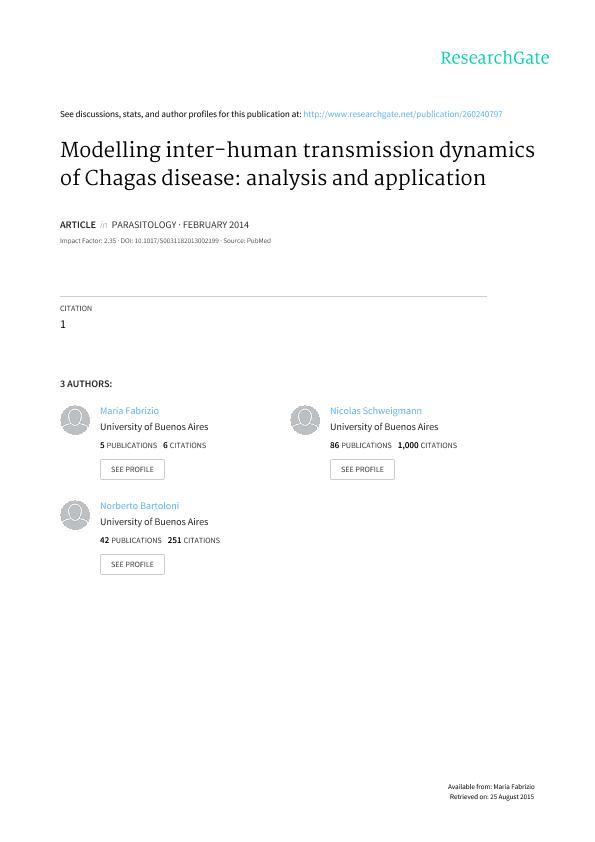Mostrar el registro sencillo del ítem
dc.contributor.author
Fabrizio, M. C.
dc.contributor.author
Schweigmann, Nicolas Joaquin

dc.contributor.author
Bartoloni, Norberto Jose

dc.date.available
2017-07-05T17:53:42Z
dc.date.issued
2014-05
dc.identifier.citation
Fabrizio, M. C.; Schweigmann, Nicolas Joaquin; Bartoloni, Norberto Jose; Modelling inter-human transmission dynamics of Chagas disease: analysis and application; Cambridge University Press; Parasitology; 141; 6; 5-2014; 837-848
dc.identifier.issn
0031-1820
dc.identifier.uri
http://hdl.handle.net/11336/19610
dc.description.abstract
Transmission of Trypanosoma cruzi, the causal agent of Chagas disease, has expanded from rural endemic to urban areas due to migration. This so-called urban Chagas is an emerging health problem in American, European, Australian and Japanese cities. We present a mathematical model to analyse the dynamics of urban Chagas to better understand its epidemiology. The model considers the three clinical stages of the disease and the main routes of inter-human transmission. To overcome the complexities of the infection dynamics, the next-generation matrix method was developed. We deduced expressions which allowed estimating the number of new infections generated by an infected individual through each transmission route at each disease stage, the basic reproduction number and the number of individuals at each disease stage at the outbreak of the infection. The analysis was applied to Buenos Aires city (Argentina). We estimated that 94% of the new infections are generated by individuals in the chronic indeterminate stage. When migration was not considered, the infection disappeared slowly and R0 = 0·079, whereas when migration was considered, the number of individuals in each stage of the infection tended to stabilize. The expressions can be used to estimate different numbers of infected individuals in any place where only inter-human transmission is possible.
dc.format
application/pdf
dc.language.iso
eng
dc.publisher
Cambridge University Press

dc.rights
info:eu-repo/semantics/openAccess
dc.rights.uri
https://creativecommons.org/licenses/by-nc-sa/2.5/ar/
dc.subject
Urban Chagas
dc.subject
Next-Generation Matrix
dc.subject
Basic Reproduction Number
dc.subject
Mathematical Model
dc.subject.classification
Ecología

dc.subject.classification
Ciencias Biológicas

dc.subject.classification
CIENCIAS NATURALES Y EXACTAS

dc.title
Modelling inter-human transmission dynamics of Chagas disease: analysis and application
dc.type
info:eu-repo/semantics/article
dc.type
info:ar-repo/semantics/artículo
dc.type
info:eu-repo/semantics/publishedVersion
dc.date.updated
2017-07-05T15:02:35Z
dc.journal.volume
141
dc.journal.number
6
dc.journal.pagination
837-848
dc.journal.pais
Reino Unido

dc.journal.ciudad
Cambridge
dc.description.fil
Fil: Fabrizio, M. C.. Universidad de Buenos Aires. Facultad de Agronomia; Argentina
dc.description.fil
Fil: Schweigmann, Nicolas Joaquin. Consejo Nacional de Investigaciones Científicas y Técnicas. Oficina de Coordinación Administrativa Ciudad Universitaria. Instituto de Ecología, Genética y Evolución de Buenos Aires. Universidad de Buenos Aires. Facultad de Ciencias Exactas y Naturales. Instituto de Ecología, Genética y Evolución de Buenos Aires; Argentina
dc.description.fil
Fil: Bartoloni, Norberto Jose. Universidad de Buenos Aires. Facultad de Agronomia; Argentina
dc.journal.title
Parasitology

dc.relation.alternativeid
info:eu-repo/semantics/altIdentifier/doi/http://dx.doi.org/10.1017/S0031182013002199
dc.relation.alternativeid
info:eu-repo/semantics/altIdentifier/url/https://www.cambridge.org/core/journals/parasitology/article/modelling-interhuman-transmission-dynamics-of-chagas-disease-analysis-and-application/31B84D8DEDC8046D86A41A289B7E69CF
Archivos asociados
